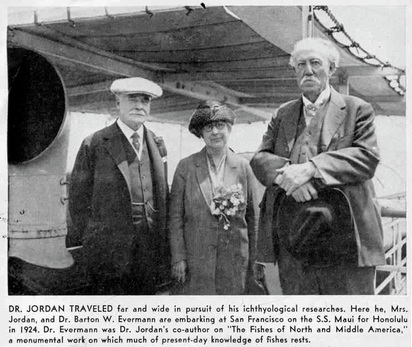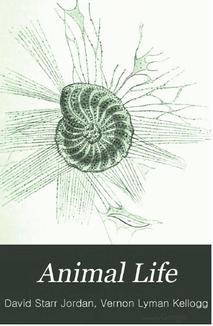His Scientific Achievements

While it is impossible to breach the scope of David Starr Jordan's scientific achievements in this website, it is important to note that he was the leading ichthyologist of his era. "He probably had a complete and intimate knowledge of a greater number of fish species than any other man of his time. Of the 12,000-13,000 species of fish then known, he and his former students discovered more than 2,500." (#3 p. 37)
Beyond that, Jordan also dealt extensively in theories of evolution and speciation that are delineated below. This specialization is due mostly to his dedication to biological inheritance, whether in regards to Darwin's theories or in support of the eugenics movement.
Beyond that, Jordan also dealt extensively in theories of evolution and speciation that are delineated below. This specialization is due mostly to his dedication to biological inheritance, whether in regards to Darwin's theories or in support of the eugenics movement.
Animal Distribution

Jordan posited that their were three laws governing the distribution of animals. These laws detail why most species of animals are not found on every corner of the earth.
1) Its individuals have been unable to reach this region, through barriers of some sort
2) The specie having reached a new geographic area are unable to maintain itself either because the lack of capacity for adaption, through the severity of competition with other forms or through destructive conditions of the environment
3) The species having reached the new geographic area adapts and alters to become distinct from its original form
Each species attempts to broaden its range and expand over a greater area of land. However, species are limited in expansion by geographic obstacles and barriers. In relation to man, Jordan contended that it is a barrier-crossing animal and can be found in all areas where human life is possible. Within the human species, different races
"find checks and barriers entirely similar in nature to those experienced by the lower animals, and the race peculiarities are wholly similar to characteristics acquired by new species under adaption to changed conditions" (#1 p.283)
David Starr Jordan believed that the laws that governed the distribution of species also governed the distribution of races. Just as with differing species, he argued that the race of man will determine whether he or she can surmount certain natural barriers. Some races are more equipped than others. As a point of summary, he concluded
"That which constitutes an impassable obstacle to one form may be a great aid to another" (#1 p.283).
1) Its individuals have been unable to reach this region, through barriers of some sort
2) The specie having reached a new geographic area are unable to maintain itself either because the lack of capacity for adaption, through the severity of competition with other forms or through destructive conditions of the environment
3) The species having reached the new geographic area adapts and alters to become distinct from its original form
Each species attempts to broaden its range and expand over a greater area of land. However, species are limited in expansion by geographic obstacles and barriers. In relation to man, Jordan contended that it is a barrier-crossing animal and can be found in all areas where human life is possible. Within the human species, different races
"find checks and barriers entirely similar in nature to those experienced by the lower animals, and the race peculiarities are wholly similar to characteristics acquired by new species under adaption to changed conditions" (#1 p.283)
David Starr Jordan believed that the laws that governed the distribution of species also governed the distribution of races. Just as with differing species, he argued that the race of man will determine whether he or she can surmount certain natural barriers. Some races are more equipped than others. As a point of summary, he concluded
"That which constitutes an impassable obstacle to one form may be a great aid to another" (#1 p.283).
Speciation
David Starr Jordan's research in animal distribution served as the precursor to his work on speciation. Speciation is the formation of new and distinct species through the course of evolution. In 1905, Jordan inaugurated his theory that isolation is a necessary first step in the process of speciation. In the journal Science, he published an article entitled "The Origin of Species Through Isolation" he stated that
"The first breeds are formed primarily by isolation. The traits of the first individuals in each region are intensified by the in-breeding resulting from segregation" ("The Origin..." 557).
However, he made the point that although isolation was an important factor to speciation, it did not belittle or demote other factors. He noted that species change through both space and time. Isolation by itself cannot do anything to alter the course of a species. The space condition relates to isolation because as the specie spreads out geographically and divides across a diversity of landscapes, its divisions may face new conditions. Changes in time lead to subsequent changes in the environment. Even though the factor of time was important, it is evident that his theory of geographic isolation plays a large role in the speciation. For these reason, he noted that the most closely related species will not be found in the same region but in adjacent regions separated by a geographical barrier.
"The first breeds are formed primarily by isolation. The traits of the first individuals in each region are intensified by the in-breeding resulting from segregation" ("The Origin..." 557).
However, he made the point that although isolation was an important factor to speciation, it did not belittle or demote other factors. He noted that species change through both space and time. Isolation by itself cannot do anything to alter the course of a species. The space condition relates to isolation because as the specie spreads out geographically and divides across a diversity of landscapes, its divisions may face new conditions. Changes in time lead to subsequent changes in the environment. Even though the factor of time was important, it is evident that his theory of geographic isolation plays a large role in the speciation. For these reason, he noted that the most closely related species will not be found in the same region but in adjacent regions separated by a geographical barrier.
